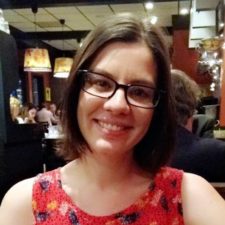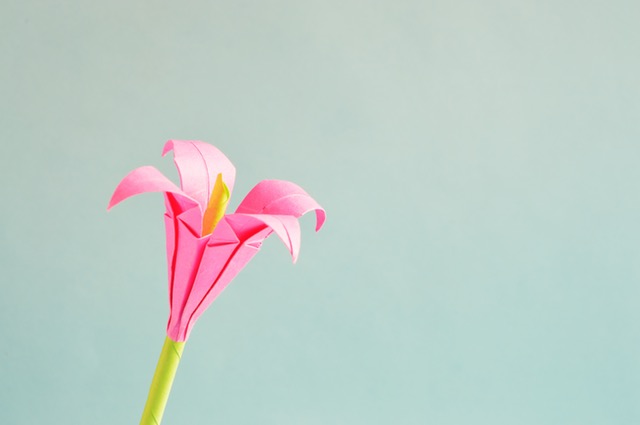My new way of breaking the ice with strangers at parties is to ask: In what context and through what source did you first learn about the atomic bomb? (Makes me very popular at parties. Or it isolates everyone. I have about a 50/50 success rate.)
What this question is really asking is, what is your background, what beliefs and ideas make you up, and what lens do you use to view the world?
I’ll tell you my answer: In 5th grade the school librarian read us “Sadako and the Thousand Paper Cranes” by Eleanor Coerr, an illustrated children’s book retelling the true story of a healthy and promising young girl who develops leukemia as the result of exposure to the detonation of the atomic bomb on Hiroshima.
It’s the first book I ever encountered that didn’t have a happy ending. Sadako doesn’t recover, and her plan to have a wish (for her life) granted by finishing 1,000 paper cranes also remains unfinished.
By the end of that book I was galvanized to fold paper cranes in memory of Sadako and to make my wish a world without nuclear weapons.
Second lesson: 9th grade History assignment, “Hiroshima” by John Hersey. This is a collection of journalistic pieces about the impacts of the bomb on the ground as it was detonated, resulting from interviews with survivors.
Decades later I learned that before they were assembled for this book, Hersey’s essays first ran in The New Yorker. Their original publication greatly impacted American perception of the bomb; this journalism ignited sympathy for the Japanese citizens hurt by the bomb and inspired waves of anti-nuke protests and movements.
Then that’s the last formal education I ever received about enriched uranium or nuclear fission. I was introduced to the bomb by exploring the damage done to a city and its human inhabitants, on a deeply personal level.
How did this frame how I see the world? You’d better believe it made me sympathetic to Japanese victims of the bomb, and terrified of a nuclear war. I grew up and went to Journalism school and became an anime fan and skated by with taking one science class and one math class between 11th grade and my 30th birthday.
I thought I had it all figured out at 13 years old, and my views changed very little over the next 15 years: scientists in the US are puppets of the military, and in collaboration these two groups play god by using nuclear power to threaten or avoid war.
Until: The election of Donald Trump in November 2016 made me evaluate many things, and one of them has been the role and character of science in relation to democracy.
American scientific inquiry and efforts are no doubt under attack right now, with potentially devastating consequences to our country and the entire world.
The need to protect science calls to me, hitting my Activist and Advocate buttons. ENGAGE. But I keep bumping into the mistrust of scientists I developed in school and through pop culture. (“Dr. Strangelove” was my favorite movie in high school, for one example.)
To respond, I have made it my personal mission to read more about science, history and facts. Indeed, to read as much nonfiction, especially about science, as I read fiction and literature. (I love fiction and literature and average a book a week for pleasure.)
I am not pitting good reporting and high literature against one another here. I’ll assume it’s obvious that I believe they both have merit. It’s just that right now, I feel the need to fill a gap in my own learning and understanding by choosing books that are challenging yet rewarding for me. It’s been worthwhile so far (but if you spoil the new “Saga” comic for me I will make you regret it!)
I’ve been reading nonfiction about scientific discoveries in a world on the brink of war, or in a changing culture. I’ve been reading about the personalities and legends that came from the Manhattan Project, the Allied governments’ funded research group that first developed nuclear weapons. I’ve been enveloped in stories about the scientists’ lives and passions, and intentions for nuclear power that did not include weapons of war.
On July 16, 1945, the first atomic weapon was detonated in the desert of New Mexico, a test with the code name “Trinity.” I’ve only recently learned about the cult of personality around many of the witnesses there. Their reactions, to a certain set, are the stuff of legend.
Ever-snarky Richard Feyman actually got to see the explosion, though all were instructed to avert their eyes. He slid into a car, knowing the windshield would block out the UV, and was able to behold a reaction that likely hadn’t existed in the universe since its creation. In the wake of the explosion, J. Robert Oppenheimer called to mind a quote from the “Bhagavad Gita,” “Now I am become Death, the destroyer of worlds.” Groovy. Stoic Enrico Fermi had shreds of paper in his hand, which he let blow out of his open palm so he could immediately estimate the impact of the blast.
All of this has been news to me, but for some these stories are old hat and easily recited on the fly.
This strikes me in several ways: One is that disorientation when you first bump into a subculture you didn’t know existed. There are groups of scientifically- or mathematically-minded people who have these stories memorized, as cultural touchstones. I am certainly tardy to that party.
Explained in word association, you say “atom bomb” and I will always say “Hiroshima and Nagasaki.” But there are folks who would first say, “Trinity Test” or “Manhattan Project.” I’m just going to call it a different subculture.
Beyond that, it makes me confront that it never occurred to me to be curious about the lives of the engineers and physicists involved in The Manhattan Project.
And that’s a writer’s death right there: It never occurred to me to be curious. If I want to be a writer I must live with a boundless, insatiable curiosity about people and the world. (Which sounds a lot like the passion that drives the world’s scientists.) If I think I’ve learned all I can learn and there’s nothing to be curious about, it’s time to stop writing.
And so I have awakened a deep inquisitive drive within myself, for more sides and a broader picture of the events that led to nuclear attacks on August 6 and August 9, 1945.
I am not talking about “alternative facts,” or a set of falsehoods spun to sound true. I am talking about a more comprehensive understanding of history, the universe, and what roles humans have in it. I am talking about a writer’s imagination being used to humanize everyone. Yes, everyone.
I’m never going to love the bomb, and I will remember Sadako and wish for peace until the day I die. But I have learned to apply the principles of humanity and curiosity much more broadly, for my own sake and for that of my writing.

Laura Eppinger graduated from Marquette University in Milwaukee, Wisconsin, USA in 2008 with a degree in Journalism, and she’s been writing creatively ever since. She the blog editor here at Newfound Journal.


0 comments on “A Case for Reading Outside Your Genre, or How I Learned To Stop Worrying and Love the Bomb”